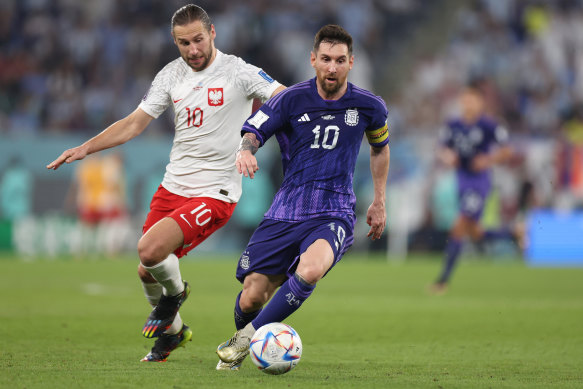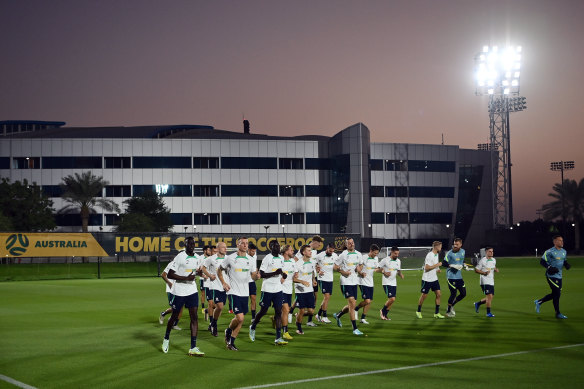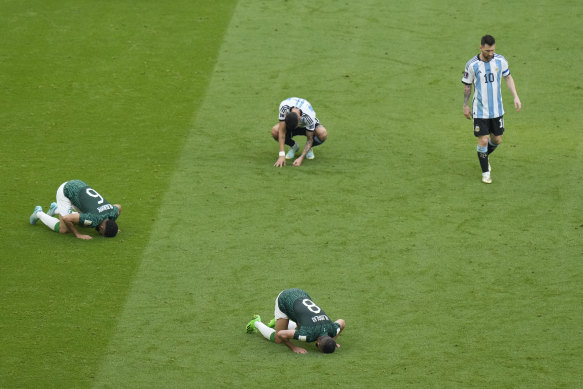This was published 2 years ago
Six burning questions as the Socceroos prepare for Messi’s Argentina
By Vince Rugari
1. How do the Socceroos stop Lionel Messi?
It’s a puzzle that even the best tacticians in the world have struggled to solve. “I’ve already said that we need a plan for Messi, and the players told me that we need to carry handcuffs and a pistol,” former Osasuna coach Petar Vasiljevic once said.
There might not be a legal solution - Leo Messi is just that good, a freakish talent with extraterrestrial qualities who has been dominating the sport for close to two decades. There is no secret, no silver bullet. But you can try.
There are a few methods worth a crack: someone can be assigned to track his runs, or ‘tag’ him as an AFL commentator might say, but Messi is also brilliant at manipulating space for teammates and could make the Socceroos pay in other ways. They can attempt to cut him off at the source, anticipate inbound passes and basically stop him from getting the ball in the first place, but that’s easy to say, not to do. They can try to keep him narrow, mindful that he will probably destroy any player in a one-v-one contest, even accounting for his declining pace. They can try to be physical and kick him into submission — if they can catch him. Australia need to keep an eye on him at all times, even when they have possession because he’s good at popping up out of nowhere. You need to prepare for what happens if you lose the ball before it happens.
Basically, they need to do all of the above, as often as they can, as well as they can. They also need to start strongly because if Messi is allowed to get his confidence up early, it could be curtains for Australia. All the best with it, lads.
2. Beyond Messi, what else should Australia’s defence prepare for?
La Albiceleste will present a different sort of challenge to the three teams they faced in Group D. France ripped the Socceroos to shreds with their pure quality, with Kylian Mbappe and Ousmane Dembele running rampant down the flanks, finding space to deliver inch-perfect crosses for Olivier Giroud which the defenders struggled to read, let alone clear. Tunisia tried to strike mostly on the break. Or they might have, if Harry Souttar gave them a chance.

Poland’s Grzegorz Krychowiak keeps a close eye on Messi.Credit: Getty
And then Denmark absolutely had Australia clinging on for dear life in the first 30 minutes but they were held at bay, and aside from one or two moments, actually struggled to generate any high-quality shots. Towards the end they had to resort to long balls, crosses and other speculative methods.
Argentina stand in stark contrast. This is a team that will hold on to the ball for as long as they can, stroke it around and try to create openings in the final third with quick, clever combination play. The Socceroos were happy to sit back and defend deep against the Danes as they were very comfortable dealing with what they were throwing at them. Here, however, they’d be well advised to use a higher defensive line, press further up the park and be aggressive in their tackling and positioning because if they’re pinned back, it could be a case of death by 1000 cuts.

The Socceroos train at their lavish Aspire Academy base.Credit: Getty
3. Is the Aspire Academy really Australia’s secret weapon?
It’s been talked up as the team’s great trump card — the $1.3 billion state-of-the-art facility where the Socceroos are eating, sleeping, training and relaxing. There are no distractions, no need to hop on a bus to get to a training ground, and no chance that their peace and serenity can be disturbed by anyone other than the travelling media who are allowed in. Even then, we only get to watch them run around for 15 minutes before we get kicked out.
It’s also right next door to Aspetar, one of the world’s most advanced sports medicine hospitals.
“They’ve got everything there for us. NormaTec guns, they have a pool, you can throw a bike in the pool and ride a bike in the pool, you can do everything,” Australia’s hero against Denmark, Mathew Leckie, says. “We’re very lucky to have that, and I think it’s been a massive advantage, especially the intensity that we play — we know as a team that we need to work harder and win our physical battles to get results.”
So here’s where the rubber hits the road: Australia’s fourth short turnaround in a row. If they’re gassed, they’re gassed. But if they’re running harder, faster and for longer than Argentina’s players, it might be time to thank Tim Cahill for hooking the Socceroos up at Aspire, where he’s the chief sports officer. For the record, Cahill - an official ambassador of Qatar’s World Cup organising committee - has declined multiple interview requests and pulled out of a planned media tour of Aspire he was to lead at the last moment.)
4. What Argentinian weaknesses can the Socceroos exploit?
It’s hard to find many chinks in the armour of a team that comes into a World Cup on the back of a 36-match unbeaten streak and are reigning continental champions. But Saudi Arabia’s shocking 2-1 win over them in their opening match does provide a couple of hints.
Herve Renard’s side clawed back from a goal down, yet in truth they could have been two or three behind at half-time, such was Argentina’s dominance. The Saudis were able to get into the match by defending high, pressing hard and refusing to defer to their higher-class opponents. Two goals in the first eight minutes of the second half — one of which was an absolute worldie from Salem Al-Dawsari — had Argentina rattled, and from there, they had to chase the game, but got increasingly tetchy as the under-siege Saudis kept turning them away, time and again. It was a heroic performance, but not exactly easy to replicate.

The aftermath of Saudi Arabia’s shock first-up win over Argentina.Credit: AP
So in summary: they’ll need a bit of luck, class, physicality, ruthlessness and grit, and for South America’s best team to have a poor night at the office.
But here’s some other good news - winger Angel di Maria, the former Manchester United star now at Juventus, is only a 50-50 chance of playing due to injury.
There, a weakness.
5. Where’s the balance between fresh legs and stability?
Graham Arnold rolled out almost the same starting team in all three of Australia’s Group D matches, with the only changes made at right-back: Nathaniel Atkinson played there against France, Fran Karacic against Tunisia, and Milos Degenek against Denmark. Clearly his selections have proved to be bang on the money, reasoning that too many mid-tournament changes would confuse his players and cloud their minds, but there was always a risk that they could be exhausted if they were to somehow manage to get out of their group. A risk worth taking, no question, but here we are in the round of 16 and it’s hard to know how much more his players have to give, and whether the ones who await in reserve will even be used.
Only five members of Arnold’s 26-man squad haven’t seen any action yet: defenders Thomas Deng and Joel King, midfielder Cameron Devlin, winger Marco Tilio (who scored against Argentina at the Olympics), and back-up goalkeepers Andrew Redmayne (more on him in a moment) and Danny Vukovic. Nine others, including creative star Ajdin Hrustic, have played a cumulative total of fewer than 90 minutes. So the options are there, fresh and ready to go. It is hard to imagine, though, Arnold suddenly entrusting someone like Deng, King or Devlin with a starting berth after three full matches on the pine.
None of Mitchell Duke, Riley McGree or Craig Goodwin, three of Arnold’s nailed-on starters, have completed a full match, which ideally will mean they have a bit more energy ready to expend on Sunday morning (AEDT).
6. Does Andrew Redmayne come on if there’s a penalty shootout?
If it comes to it ... it has to happen, right? Especially since this match is being played at the Ahmed bin Ali Stadium in Doha’s western outskirts - the very same venue where Graham Arnold shocked everyone by subbing off Maty Ryan for Andrew Redmayne in the dying moments of extra time against Peru. We all know what happened next. If Arnold has any sense of theatre, the ‘Grey Wiggle’ has to be deployed again, although since the Socceroos have new kits, he could be the Maroon, Turquoise or Purple Wiggle this time, with sincere apologies to Jeff.
Arnold deflected when the question was put to him this week. “I don’t think the heart can put up with that at the moment,” he said. Redmayne was also coy when asked, saying that he, Arnold and goalkeeping coach John Crawley hadn’t gone into that sort of detail yet. That, with respect to all three of them, is hard to believe given how meticulously they planned out their last collaboration.
There won’t be a surprise factor this time. Argentina will have surely planned for the possibility of seeing Redmayne’s big ginger beard emerge from the dugout, especially after seeing him put their CONMEBOL rivals to the sword. But it’s one thing to know it’s coming, and quite another to hold your nerve when your opponent is resorting to what is effectively psychological warfare against you.
In an interview with the Herald earlier this year, the 33-year-old hinted he had more tricks up his sleeve. “I think against Peru, the world saw the kind of refined version of the Wiggles routine. I was wary after getting numerous warnings about going too far, pushing the limits too far,” he said.
“There were a few little things that I had in the back of my head that I could do a bit more outside the box. And I think if it was a standalone A-League fixture penalty, 80th minute, I probably would have done a few other things. But I think as well, I’ve learned a few things from that, and what I could do better and how I could further enhance my team’s advantage in a penalty situation. Everything’s a learning curve.”
Watch every match of the UEFA Champions League, UEFA Europa League and UEFA Europa Conference League on Stan Sport. Returns for the Round of 16 in February 2023, with all matches streaming ad-free, live and on demand.